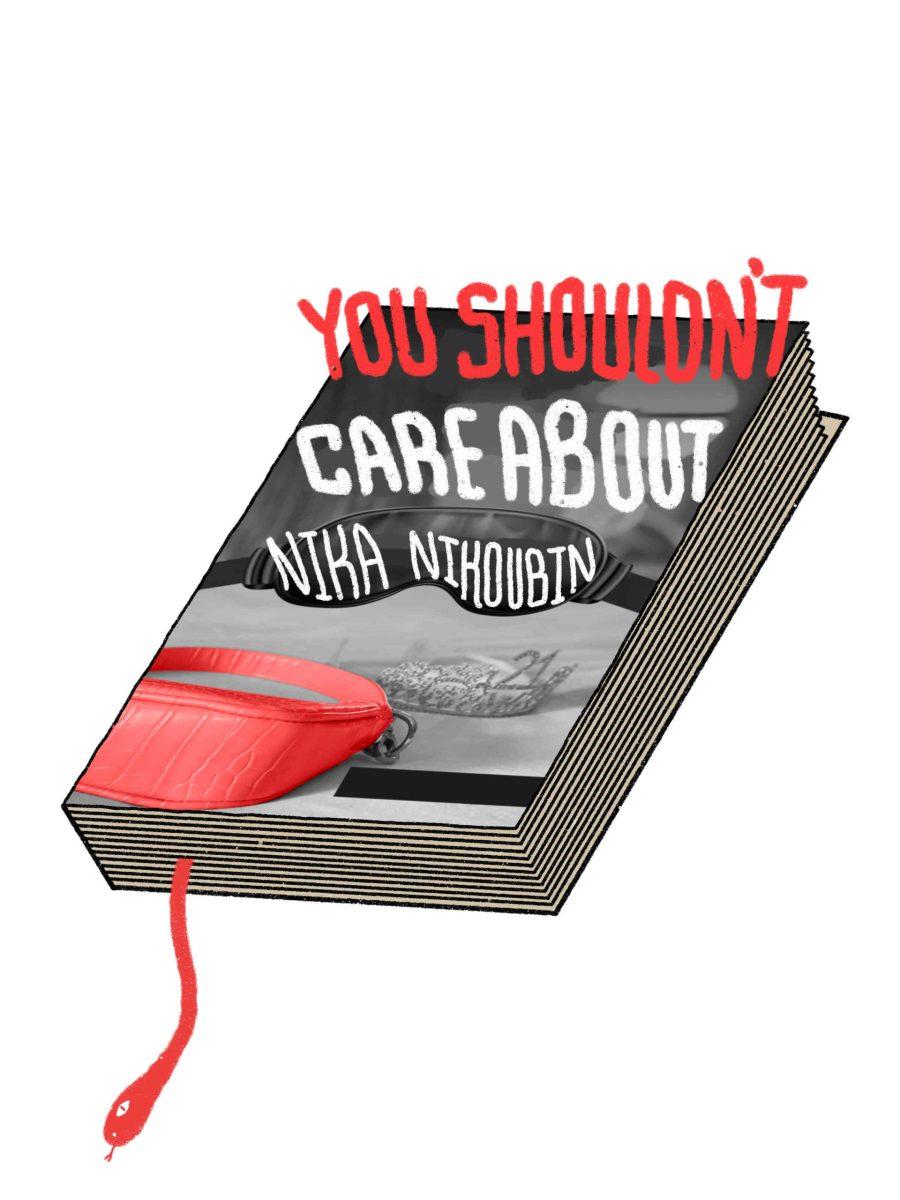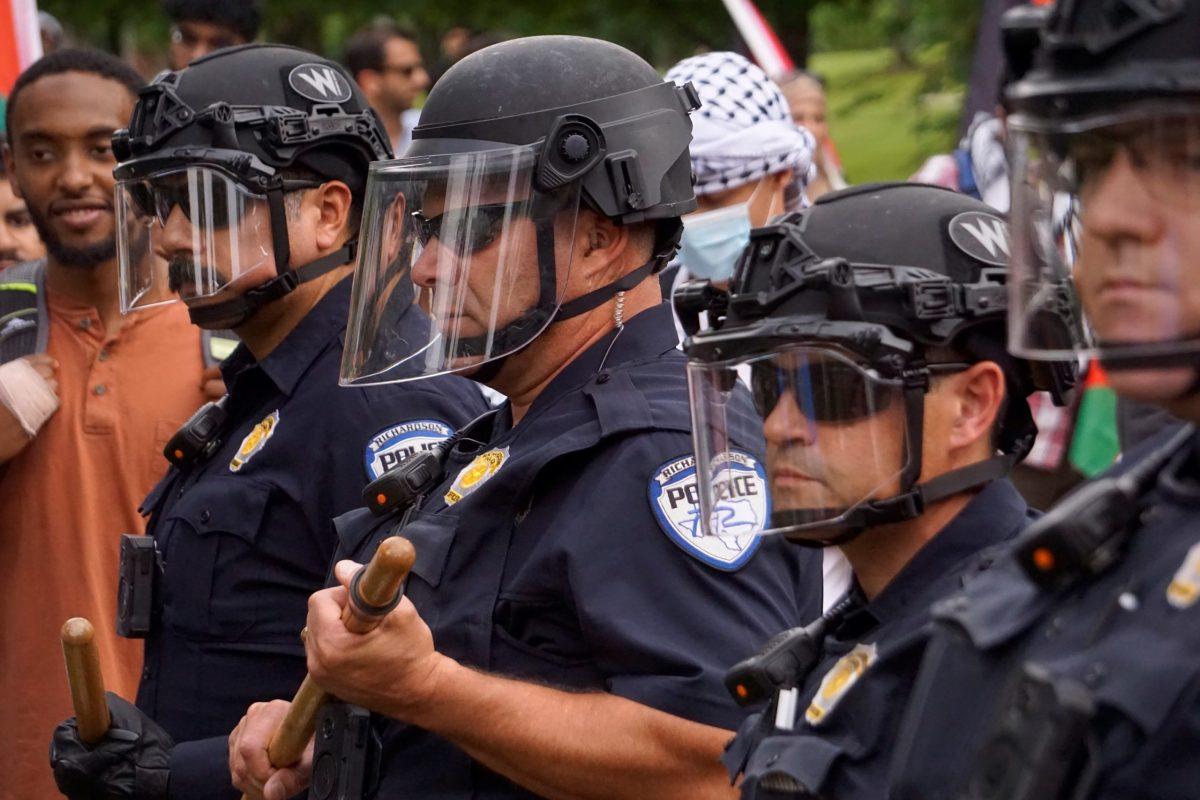Infamous UTD felon Nika Nikoubin’s new autobiography “Who is Nika Nikoubin? A Bloody Las Vegas Hotel Story” is larger than life, dramatically illustrating the high-profile March 2022 attempted murder for which Nikoubin was recently sentenced to probation. Despite its theatrics and tell-all detail, however, this book sports flaw after crippling flaw. Unless you like atrociously written, dubiously true, victim complex-ridden money grabs, you would be better off reading a phonebook.
Nikoubin’s crime was perfect headline fodder. She accompanied her blind date to a hotel, blindfolded him, and in the middle of sex stabbed him in the neck twice. When speaking to police, Nikoubin described the attack as revenge for the U.S.’s murder of a top Iranian general, which she later denounced as part of her delusional state. Her victim survived, and Nikoubin was convicted of two counts of false imprisonment with a deadly weapon, receiving a probation sentence in August 2023 after arguing she was in a manic state but was now medicated and working with a psychiatrist. After Nikoubin’s crime was discovered by UTD students and she was banned from campus, mass media caught hold of her story. Nikoubin quickly capitalized on the newfound fame: grinding out auto-tuned covers of other people’s music, hosting concerts, giving interviews, sending her PR team after negative press, starting a podcast … and publishing this book.
“Who is Nika Nikoubin?” is a chronological account of Nikoubin’s life, starting from her early childhood in Tehran, through her adolescence in Lubbock, Texas, to her tumultuous college years marred by struggles with trauma, depression and manic episodes. No detail is spared when discussing her drugged-out trip to Vegas, the attempted murder, the sex act leading up to it, her police custody and weeks of jail time and her subsequent freedom and fame. Nikoubin claims the book was written for other girls with mental health struggles, which would be a nice sentiment if the book were even slightly respectable.
I supposed the attempted murder charge was also not a petty crime.
Nika NikoubinStory continues below advertisement
Unfortunately for Nikoubin, my copy of her book is annotated with the pen-and-paper equivalents of infuriated keyboard smashes. Her description of the events surrounding the stabbing ranges from extremely dubious to downright fabricated. During her sentencing, Nikoubin claimed the incident was “difficult for [her] to remember,” unable to tell what was real and what was fake, but in her book, she delivers an extremely clear and intricate account of that night. She claims to have hallucinated herself as Salma Hayek – or “Selma” as she repeatedly misspells – in the dancing scene from “Dusk Til Dawn,” needing to successfully perform her role while a song told her to “win” over her victim.
Despite being manic, stressed and inebriated, she recalls precise details, timelines and thought processes, biological improbabilities for her mental state. It is notable that the Salma Hayek narrative didn’t emerge until she started giving interviews with the press. While I don’t doubt that Nikoubin was having a psychotic episode during the crime, we cannot be certain that the details provided in the book are true. She certainly has no problem with the minor factual errors littering her book, such as claiming UCLA is the top college in America, or claiming on social media that her cover song is a “hit single” and that she produces as well as sings. She has much to gain from the media spotlight by embellishing her story. Frankly, her recollection cannot be trusted.
The questionable factuality of Nikoubin’s account is not even my main issue with the book. What brought tears of rage to my eyes was how devastatingly little Nikoubin cares about her victim. She dehumanizes him, never giving him a line of dialogue nor even mentioning him after her arrest. She spares no thought to how he must have felt or how she regrets hurting him, displaying remarkably little empathy. Even the book cover betrays this: its darkly sexy BDSM romance vibe, featuring a blindfold like what she used on her victim, is completely inappropriate and commodifies the felony she committed into an erotic, mysterious adventure.
To Nikoubin, her victim isn’t a person worthy of consideration in her autobiography about nearly killing him, but a warm body that simply happened to be affected during her mental break; she egregiously refers to him as “George Clooney” while calling herself “Salma Hayek.” Everything in her world centers around her, while he stops existing as soon as the knife lodges in. The irony is especially bitter considering how, at Nikoubin’s sentencing, the victim clearly expressed a desire to move on. By dredging this case up repeatedly through ventures like the book or her new podcast, she denies him the reprieve he seeks. And despite his request for privacy, she spares no unnecessary, pornographic details on the acts preceding the crime. His wishes mean nothing to her.
Instead of respecting her victim, Nikoubin is more interested in portraying herself as the victim of the story. She justifies her crime incessantly by bringing up her past sexual trauma, how her victim’s mocking comments had upset her and how he asked for pain and domination during sex, obviously fishing for sympathy where she deserves none.
The book’s narrative only works if one views Nikoubin as a helpless victim reacting to desperate circumstances, shifting the blame onto the man she stabbed. The truth is that Nikoubin may have had a psychotic episode, but that does not magically absolve her of the crime. Nikoubin herself admits that in Vegas, she stopped taking her medication and had been drinking — both risk factors for an episode in someone already diagnosed with schizophrenia and bipolar disorder. And in the months since, while she may be adhering to probation requirements, her public behavior shows that she feels little guilt or accountability for what happened.
From living in Berkley [sic], I was exposed to everything from cryotherapy to veganism.
Nika Nikoubin
Ceaseless discussion follows of how the crime impacted her — how jail traumatized her and the media judged her — yet not a thought is spared to the man she tried to kill. She spends more time ruminating on how the photo of her published in the press was not pretty than she does considering her victim. Throughout the book, she insists “I’m not a victim,” implying we are meant to perceive her like one at first while nominally denying her self-centered attitude. It is astonishing how the perpetrator of two felony stabbings can talk like she is the only one suffering.
I said ‘SORRY’ and ran out of the room naked with a butt plug still inside me.
Nika Nikoubin – Sensationalizing, as Always
A more niche but extremely noticeable flaw with Nikoubin’s autobiography is its sloppiness. Evidently, it has not seen an editor’s desk; typos pepper every page, incoherent paragraphs are strung into messy narratives and long sections are boring, unneeded fluff. It is obvious that Nikoubin tried to maximize the page count: the font is huge, and each page is drowning in white space and unnecessary song lyrics, evoking a chapter book meant for fourth graders. At the same time, much of the biographical portion is needlessly detailed and painfully irrelevant to the “bloody Vegas hotel story.” It reads like a rough draft, not a professional publication. Nikoubin struggles to decide whether this book is an actual autobiography or a theatrical justification of her crime; ultimately, she settles for failing at both.
What might have redeemed this book is a positive message. Nikoubin claims in her conclusion that she wrote it for girls who struggle with mental health issues, but that message rings exceptionally hollow. Nowhere in her self-interested, dramatized account is any consideration of her audience—besides trying to make herself seem sympathetic, of course. She doesn’t discuss the warning signs of bipolar disorder or schizophrenia or try to destigmatize them for the audience. She doesn’t explain how she’s healing and what she’ll do differently this time. She spends half the book discussing all the negatives of medication but doesn’t explain how they can help and why she ultimately chooses to take them — hint, a court order.
I was hallousinating [sic] a snake around my shoulders just like the dance scene from the movie [Dusk Til Dawn.]
Nika Nikoubin
For someone trying to understand bipolar or schizophrenia, the book’s overuse and under-explanation of terms like “manic” offer little insight. For a young girl with a mood disorder, reading about a graphic crime with very little follow-up or explanation Nikoubin’s recovery might imply that these disorders guarantee eventual criminality. At one point, Nikoubin discusses how a ten-day psychiatric ward stay couldn’t help her, but expects us to uncritically believe that working with a psychiatrist once a week has completely healed her. How can Nikoubin’s book help others when we can’t even be sure her own mental health is under control?
Nikoubin just wants to talk about herself under the guise of being a “mental health advocate.” This book doesn’t advocate for anything. It doesn’t shatter stereotypes, or showcase personal growth despite the odds, or offer any proof that crises like these are avoidable. It just fetishizes a mania-induced crime for the sake of profit.
I strongly recommend against buying this book, even to read it ironically. Purchasing this book financially supports Nikoubin and her attempt to twist the tragic event into a sympathetic, eye-catching cash cow that exploits her victim despite his wishes. The best way to respond to Nikoubin’s desperate clawing for fame is to ignore her instead of enabling her. Don’t feed her need for attention; let this story — and her victim — fade into obscurity. You already know exactly who Nika Nikoubin is.










